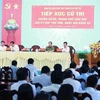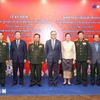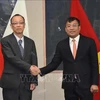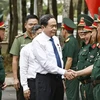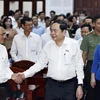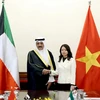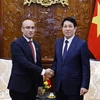It is impossible to say that Vietnam’s sovereignty over Hoang Sa and Truong Sa archipelagoes has been dented because the country lacks sovereignty declaration and exercise, said Lawyer, Dr. Ta Van Tai, a postgraduate of Harvard Law School, in an interview with the People’s Army Newspaper.
The lawyer was talking about the legal and historical foundation proving China’s violation of Vietnam's sovereignty when it placed its oil rig Haiyang Shiyou-981 in Vietnam’s exclusive economic zone and continental shelf in the East Sea early last month.
Regarding Vietnam’s interests in the East Sea under the United Nations Convention on the Law of the Sea in 1982 (1982 UNCLOS), Tai held that Vietnam has two national interests.
First, its territorial sovereignty over a large number of islands and coral reefs in Hoang Sa (Paracel) and Truong Sa (Spartly) archipelagoes, which Vietnam declared and exercised sovereignty from the past in line with international law, was founded hundreds of years ago until some locations was forcibly occupied by China.
Second, Vietnam has its interests or rights over the waters and the seabed under the waters in the East Sea, including its sovereign right to exploit sea resources including fish, ore, metal, and oil and gas in the exclusive economic zone and the continental shelf.
The lawyer also pointed out that under UNCLOS, the sovereign right in EEZ and continental shelf of Vietnam, a coastal state, is exclusive; thus, Vietnam, in its EEZ, has the right to build artificial islands, structures, do marine research and protect the marine environment, while respecting other states’ rights relating to the freedom of navigation, the laying of submarine cables or pipelines (under UNCLOS’s Articles 56 and 58). In addition, in its EEZ, Vietnam has an exclusive right of exploitation of natural resources without any declaration or occupation and no other states could undertake the activity without Vietnam’s consent (UNCLOS’s Article 77).
Therefore, Tai stressed that Vietnam should make clear and lay stress on the confirmation of international law on Vietnam’s rights in the East Sea.
To further clarify China’s violations of UNCLOS, Tai said that China, a coastal state, unilaterally hinders the freedom of navigation by deploying many warships and other vessels around the drilling rig Haiyang Shiyou – 981, violating UNCLOS on the freedom and right of navigation, aviation or the freedom and right of laying submarine cables and pipelines, as well as the exploitation of the sea for other purposes which are recognised internationally.
Another China’s violation is that instead of obeying steps of negotiation on its differences with Vietnam on EEZ and continental shelf in the spirit of understanding and cooperation together with temporary measures, China had provocative acts in the East Sea. On the contrary, while waiting for judgment from jurisdiction bodies, Vietnam has limited its operation in lots 118 and 119.
China, as Tai said, has also violated the Declaration on the Conduct of Parties in the East Sea (DOC).
About China’s arguments to vindicate its illegal placement of the giant oil rig in Vietnam’s exclusive economic zone and continental shelf, Tai held that over the past time, the Chinese Foreign Ministry has avoided citing its groundless “cow-tongue line” or “nine-dashed line” which was questioned by Chinese, Vietnamese and international scholars. When placing the oil rig between Vietnam’s oil lots 142 and 143 in Vietnam’s EEZ, China said that the rig was placed within the waters of Hoang Sa Archipelago. In fact, Hoang Sa Archipelago belongs to Vietnam’s sovereignty. China wanted to refer to the EEZ and continental shelf of Hoang Sa Archipelago that it used force to seize it from Vietnam.
According to Tai, there will be two possible lawsuits to refute China’s argument on the EEZ of Hoang Sa Archipelago to claim China's right to exploit for the oil rig. In the files, Vietnam should make clear two points.
First, Hoang Sa Archipelago does not belong to China’s territorial sovereignty, but belongs to Vietnam indeed.
Second, Hoang Sa Archipelago has no rock-top or cape, even Phu Lam, deserved to be called an island where local inhabitants had lived in a self-sufficient economy in natural status. Hoang Sa has only rock and nothing else.
Based on historical evidences on its sovereignty under international law, Vietnam, over many centuries in its long history, has confirmed and exercised its sovereignty over Hoang Sa and Truong Sa archipelagoes. China used force to occupy Hoang Sa in 1974 and was opposed by the administration of the Republic of Vietnam. Later on, the Democratic Republic of Vietnam raised its voice against China’s use of force to occupy Hoang Sa, as well as some islands of Truong Sa Archipelago in 1988. Therefore, it is impossible to say that Vietnam’s sovereignty over Hoang Sa and Truong Sa archipelagoes has been dented because of the lack of sovereignty declaration and exercise.
About another possible lawsuit, Tai held that Vietnam might sue China at the International Tribunal for the Law of the Sea (ITLOS) pursuant to a compulsory procedure in UNCLOS. At this tribunal, Vietnam is able to reject China’s so-called legal foundation used to justify its illegal placement of the drilling rig Haiyang Shiyou - 981 in Vietnam’s exclusive economic zone and continental shelf.
The lawyer stressed that Vietnam might rely on law to affirm that the place where the rig is stationed lies within Vietnam’s continental shelf, completely on the Vietnam’s side. And if required, a negotiation under the convention should be held to find out a median line between the two continental shelves.
Under UNCLOS, parties concerned are asked to negotiate and reconciliation is also referred before compulsory proceedings are applied. Therefore, bilateral and multilateral diplomatic negotiations are a must. In bilateral negotiations, if hegemony overwhelms, multilateral negotiations in ASEAN and even outside the region are necessary.
The multilateral diplomacy solution is expected to check China’s erroneous acts.
Tai further elaborated that Vietnam can rely on international organisations around the world to denounce China’s erroneous acts in the East Sea among the world’s public opinion and to make resolutions against China’s acts.
He also recommended Vietnam to bring the case to the United Nations General Assembly, even the United Nations Security Council because a United Nations General Assembly’s resolution would bear pressure from international public opinion that can stop China erroneous acts. Despite the fact that a decision at the United Nations Security Council might be vetoed by China, still Vietnam should bring it to this UN’s body as it is a required procedure a state should do whenever there appears a threat to the world’s peace and security. China in fact has deployed warships and used aggressive measures, including ramming, colliding and firing water cannons at Vietnamese ships. These China’s aggressive acts are certainly protested by international opinion, while putting the world public to Vietnam’s side.
The lawyer finally quoted a doctor from Washington-based Centre for Strategic and International Studies as saying that it is optimal for Vietnam to prevent the operation of China’s massive oil rig in Vietnam’s exclusive economic zone and continental shelf in the East Sea, to order its marine surveillance ships to approach the oil rig to assert Vietnam’s sovereignty, and not to use force to retaliate Chinese vessels’ aggressive actions so as to avoid any escalating tension in the region.-VNA
The lawyer was talking about the legal and historical foundation proving China’s violation of Vietnam's sovereignty when it placed its oil rig Haiyang Shiyou-981 in Vietnam’s exclusive economic zone and continental shelf in the East Sea early last month.
Regarding Vietnam’s interests in the East Sea under the United Nations Convention on the Law of the Sea in 1982 (1982 UNCLOS), Tai held that Vietnam has two national interests.
First, its territorial sovereignty over a large number of islands and coral reefs in Hoang Sa (Paracel) and Truong Sa (Spartly) archipelagoes, which Vietnam declared and exercised sovereignty from the past in line with international law, was founded hundreds of years ago until some locations was forcibly occupied by China.
Second, Vietnam has its interests or rights over the waters and the seabed under the waters in the East Sea, including its sovereign right to exploit sea resources including fish, ore, metal, and oil and gas in the exclusive economic zone and the continental shelf.
The lawyer also pointed out that under UNCLOS, the sovereign right in EEZ and continental shelf of Vietnam, a coastal state, is exclusive; thus, Vietnam, in its EEZ, has the right to build artificial islands, structures, do marine research and protect the marine environment, while respecting other states’ rights relating to the freedom of navigation, the laying of submarine cables or pipelines (under UNCLOS’s Articles 56 and 58). In addition, in its EEZ, Vietnam has an exclusive right of exploitation of natural resources without any declaration or occupation and no other states could undertake the activity without Vietnam’s consent (UNCLOS’s Article 77).
Therefore, Tai stressed that Vietnam should make clear and lay stress on the confirmation of international law on Vietnam’s rights in the East Sea.
To further clarify China’s violations of UNCLOS, Tai said that China, a coastal state, unilaterally hinders the freedom of navigation by deploying many warships and other vessels around the drilling rig Haiyang Shiyou – 981, violating UNCLOS on the freedom and right of navigation, aviation or the freedom and right of laying submarine cables and pipelines, as well as the exploitation of the sea for other purposes which are recognised internationally.
Another China’s violation is that instead of obeying steps of negotiation on its differences with Vietnam on EEZ and continental shelf in the spirit of understanding and cooperation together with temporary measures, China had provocative acts in the East Sea. On the contrary, while waiting for judgment from jurisdiction bodies, Vietnam has limited its operation in lots 118 and 119.
China, as Tai said, has also violated the Declaration on the Conduct of Parties in the East Sea (DOC).
About China’s arguments to vindicate its illegal placement of the giant oil rig in Vietnam’s exclusive economic zone and continental shelf, Tai held that over the past time, the Chinese Foreign Ministry has avoided citing its groundless “cow-tongue line” or “nine-dashed line” which was questioned by Chinese, Vietnamese and international scholars. When placing the oil rig between Vietnam’s oil lots 142 and 143 in Vietnam’s EEZ, China said that the rig was placed within the waters of Hoang Sa Archipelago. In fact, Hoang Sa Archipelago belongs to Vietnam’s sovereignty. China wanted to refer to the EEZ and continental shelf of Hoang Sa Archipelago that it used force to seize it from Vietnam.
According to Tai, there will be two possible lawsuits to refute China’s argument on the EEZ of Hoang Sa Archipelago to claim China's right to exploit for the oil rig. In the files, Vietnam should make clear two points.
First, Hoang Sa Archipelago does not belong to China’s territorial sovereignty, but belongs to Vietnam indeed.
Second, Hoang Sa Archipelago has no rock-top or cape, even Phu Lam, deserved to be called an island where local inhabitants had lived in a self-sufficient economy in natural status. Hoang Sa has only rock and nothing else.
Based on historical evidences on its sovereignty under international law, Vietnam, over many centuries in its long history, has confirmed and exercised its sovereignty over Hoang Sa and Truong Sa archipelagoes. China used force to occupy Hoang Sa in 1974 and was opposed by the administration of the Republic of Vietnam. Later on, the Democratic Republic of Vietnam raised its voice against China’s use of force to occupy Hoang Sa, as well as some islands of Truong Sa Archipelago in 1988. Therefore, it is impossible to say that Vietnam’s sovereignty over Hoang Sa and Truong Sa archipelagoes has been dented because of the lack of sovereignty declaration and exercise.
About another possible lawsuit, Tai held that Vietnam might sue China at the International Tribunal for the Law of the Sea (ITLOS) pursuant to a compulsory procedure in UNCLOS. At this tribunal, Vietnam is able to reject China’s so-called legal foundation used to justify its illegal placement of the drilling rig Haiyang Shiyou - 981 in Vietnam’s exclusive economic zone and continental shelf.
The lawyer stressed that Vietnam might rely on law to affirm that the place where the rig is stationed lies within Vietnam’s continental shelf, completely on the Vietnam’s side. And if required, a negotiation under the convention should be held to find out a median line between the two continental shelves.
Under UNCLOS, parties concerned are asked to negotiate and reconciliation is also referred before compulsory proceedings are applied. Therefore, bilateral and multilateral diplomatic negotiations are a must. In bilateral negotiations, if hegemony overwhelms, multilateral negotiations in ASEAN and even outside the region are necessary.
The multilateral diplomacy solution is expected to check China’s erroneous acts.
Tai further elaborated that Vietnam can rely on international organisations around the world to denounce China’s erroneous acts in the East Sea among the world’s public opinion and to make resolutions against China’s acts.
He also recommended Vietnam to bring the case to the United Nations General Assembly, even the United Nations Security Council because a United Nations General Assembly’s resolution would bear pressure from international public opinion that can stop China erroneous acts. Despite the fact that a decision at the United Nations Security Council might be vetoed by China, still Vietnam should bring it to this UN’s body as it is a required procedure a state should do whenever there appears a threat to the world’s peace and security. China in fact has deployed warships and used aggressive measures, including ramming, colliding and firing water cannons at Vietnamese ships. These China’s aggressive acts are certainly protested by international opinion, while putting the world public to Vietnam’s side.
The lawyer finally quoted a doctor from Washington-based Centre for Strategic and International Studies as saying that it is optimal for Vietnam to prevent the operation of China’s massive oil rig in Vietnam’s exclusive economic zone and continental shelf in the East Sea, to order its marine surveillance ships to approach the oil rig to assert Vietnam’s sovereignty, and not to use force to retaliate Chinese vessels’ aggressive actions so as to avoid any escalating tension in the region.-VNA

